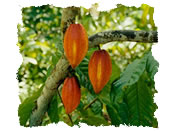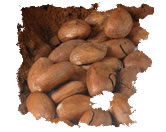|
|
|
Cocoa transformation process
|
Originally, the first cocoa processing plants were installed in Côte d'Ivoire to treat non-exported beans out of standards » or seeding between 120 and 135 beans/100G. The products obtained were then exported. Since ten years ago, the capacity of cocoa processing has experienced an increase and has brought the local processing companies to treat good quality beans as well.
The cocoa bean processing has brought to a great variety of semi-products or products manufactured. During the season 1999/2000, Côte d'Ivoire has transformed 18% of its production of cocoa beans (i.e. 240,000 tons) mainly in semi-products. The transformation of cocoa beans into chocolate includes three groups of technological operations:
|
| |
|
|
| |
1. |
The treatment of cocoa beans
|
| |
|
| |
 |
Pre-cleaning : The beans are taken away from non-essential materials. The defaulted beans are taken out. |
| |
 |
Pre-drying : The beans are warmed up through infra-red operations: the further separation of the shell is effective. |
| |
 |
Grinding :
Cocoa beans are ground then the shells are eliminated by ventilation. |
| |
 |
Alcalinization :
This process is undertaken at the time of the grinding of cotyledons, allowing time to adjust the color of the powder, according to the preferences of the customers. |
| |
 |
Roasting :Waste of cotyledons are called nibs, are roasted, by charge or continuously, between 120 and 140 degrees Celsius. The roasting develops the chocolate flavor from precursors in the cotyledons. Operating parameters must be adjusted to the type of treated beans. |
| |
 |
Grinding and refining : The wastes of cotyledons already roasted are processed into liquid paste, called paste or cocoa liquor, with the help of grindstones. The refining process reduces the granulometry of particles up to the height between 40 and 50. |
|
| |
|
|
| |
2. |
The production of chocolate
|
| |
|
| |
 |
Mixing :
The mass of cocoa is mixed with other raw materials (sugar and probably milk) up to the obtaining of homogenous paste. |
| |
 |
Milling :
The granulometry of the paste is still reduced, with the help of grinders, refining outlets up to the height between 20 and 25. |
| |
 |
Conching :
The paste is submitted to a constant and permanent movement, in a warm situation, in some conching outlets to acquire all its slenderness and creaminess. |
| |
 |
Tempering :
Before its shaping, the paste must be brought with precision at the temperature which help crystallize in a stable way the cocoa butter. This operation brings to a bright and crispy and blending. |
| |
 |
Moulding and coating : After tempering, the chocolate could be molded in the moldings or enrolled around some coating outlets. |
|
| |
|
|
| |
3. |
The production of cocoa powder
|
| |
|
| |
 |
Pressing : Après grinding the roasted beans, the cocoa butter is separated by pressing the paste. |
| |
 |
Pulverizing : After the extraction of butter, the grinding of waste leaeds to the production of cocoa powder. Two types of cocoa powder exist : 10% and 20% of materials (residue)
|
|
|
|
|








